Intel Haswell-EP Xeon 14 Core Review: E5-2695 V3 and E5-2697 V3
by Ian Cutress on November 20, 2014 10:00 AM ESTGaming Benchmarks
While the last thought on the minds of most Xeon users is related to gaming, we frequently get requests to test gaming performance on Xeons. As a result we strap the Xeon to a regular consumer level motherboard that can support them and add in one or two GPUs to see how they perform and if more cores makes a difference over the drop in frequency. Unfortunately due to the orientation of the PCIe slots on the 2P board, we were unable to test the dual E5-2697 v3 configuration.
F1 2013
First up is F1 2013 by Codemasters. I am a big Formula 1 fan in my spare time, and nothing makes me happier than carving up the field in a Caterham, waving to the Red Bulls as I drive by (because I play on easy and take shortcuts). F1 2013 uses the EGO Engine, and like other Codemasters games ends up being very playable on old hardware quite easily. In order to beef up the benchmark a bit, we devised the following scenario for the benchmark mode: one lap of Spa-Francorchamps in the heavy wet, the benchmark follows Jenson Button in the McLaren who starts on the grid in 22nd place, with the field made up of 11 Williams cars, 5 Marussia and 5 Caterham in that order. This puts emphasis on the CPU to handle the AI in the wet, and allows for a good amount of overtaking during the automated benchmark. We test at 1920x1080 on Ultra graphical settings.
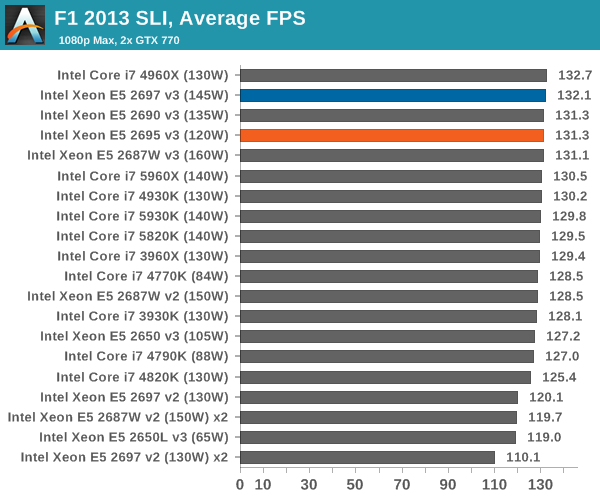
Bioshock Infinite
Bioshock Infinite was Zero Punctuation’s Game of the Year for 2013, uses the Unreal Engine 3, and is designed to scale with both cores and graphical prowess. We test the benchmark using the Adrenaline benchmark tool and the Xtreme (1920x1080, Maximum) performance setting, noting down the average frame rates and the minimum frame rates.
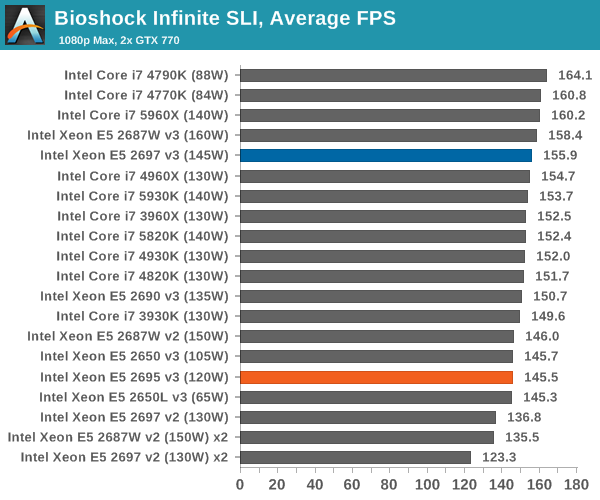
Tomb Raider
The next benchmark in our test is Tomb Raider. Tomb Raider is an AMD optimized game, lauded for its use of TressFX creating dynamic hair to increase the immersion in game. Tomb Raider uses a modified version of the Crystal Engine, and enjoys raw horsepower. We test the benchmark using the Adrenaline benchmark tool and the Xtreme (1920x1080, Maximum) performance setting, noting down the average frame rates and the minimum frame rates.
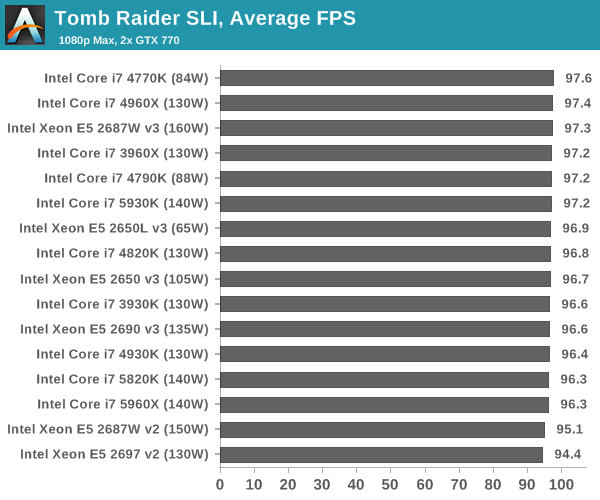
Notice zero results from Tomb Raider from our new CPUs? This benchmark does not seem to like any arrangement above 12 cores per socket, and refuses to run.
Sleeping Dogs
Sleeping Dogs is a benchmarking wet dream – a highly complex benchmark that can bring the toughest setup and high resolutions down into single figures. Having an extreme SSAO setting can do that, but at the right settings Sleeping Dogs is highly playable and enjoyable. We run the basic benchmark program laid out in the Adrenaline benchmark tool, and the Xtreme (1920x1080, Maximum) performance setting, noting down the average frame rates and the minimum frame rates.
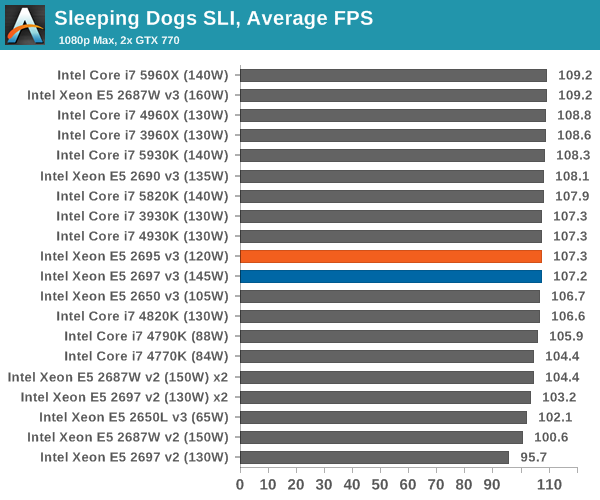
Battlefield 4
The EA/DICE series that has taken countless hours of my life away is back for another iteration, using the Frostbite 3 engine. AMD is also piling its resources into BF4 with the new Mantle API for developers, designed to cut the time required for the CPU to dispatch commands to the graphical sub-system. For our test we use the in-game benchmarking tools and record the frame time for the first ~70 seconds of the Tashgar single player mission, which is an on-rails generation of and rendering of objects and textures. We test at 1920x1080 at Ultra settings.
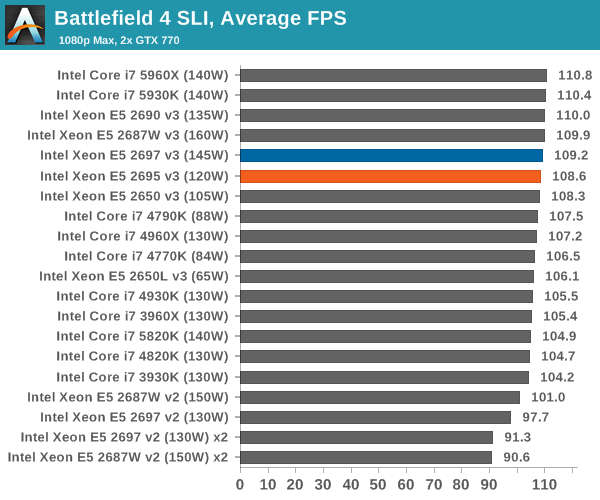















44 Comments
View All Comments
martinpw - Thursday, November 20, 2014 - link
Of interest - Intel did a custom version of the 2698 called the 2698A for Lenovo which pushes the base clock from 2.3 to 2.8GHz. It is water cooled.aka_Warlock - Thursday, November 20, 2014 - link
14 core gaming benchmarks!???!! Wtf?? Who the f*** cares?? Where are the virtualization benches??? Ffs... This is just too god damn poor.wallysb01 - Thursday, November 20, 2014 - link
And I’m pretty sure this has been a main complaint through out this whole E5-2600v3 review, but no action to fix it.SanX - Thursday, November 20, 2014 - link
You take 4790k overclicked to 5GHz and it will win most of single chip benchmarks lolname99 - Thursday, November 20, 2014 - link
"If it happens in a core as part of the logic or caches, that core can be fused off and the die can sold as a lower core part. This is how yields are improved, by reusing the dies that have errors in removable sections."Is this REALLY the case? We've heard this claim for years, but the only case I know of where it's actually been verified is when AMD was selling 3-core CPUs harvested from 4-core dies.
The reason I am dubious is that, if this is such a great system for increasing profits, how come the ONLY place it ever seems to be used is in Intel's server models?
POWER does not sell dies with random numbers of cores. (Or more precisely they talk about 6, 8, 10 and 12 processor variants but, as far as I can tell, each one of these is a separate die. Certainly they have showed the die shots for the 6 processor version.)
ARM does not do this. There are, as far as I know, no ARM phones that save a buck by using three cores harvested from a four core die, even though that would make sense for many markets and many use cases.
Even Intel does not do this outside Xeons. It's the same story as ARM --- given Intel's crazy market segmentation, again there'd certainly be a market for 3-core i7's harvested from 4-core i7's and priced appropriately.
looncraz - Friday, November 21, 2014 - link
From my understanding, some higher models with defects are binned to lower models even if specific dies exist for those lower models.For instance, it could be the case that some i3s are binned i5s, but it would probably be only a few percent of the total number of chips.
chekk - Thursday, November 20, 2014 - link
Power consumption delta is still undesirable. Please Ian, Ryan et al, go back to separate idle and load measurements.kordian - Friday, November 21, 2014 - link
Again, why are there no database scalability benchmarks or virtualization benchmarks? Redis is single-threaded, so of course a high-clocked desktop processor will win - it doesn't take advantage of the main strength of these processors - their huge number of cores. Can we please drop the gaming benchmarks on these and get some benchmarks that reflect the use of a 36 core dual socket box.antialienado - Friday, November 21, 2014 - link
This is an important idea that Anandtech should implement to differentiate itself and add value: Create an Anandtech designation for processors.It could be based on performance, and some common metrics, number of cores, , and many features, but it should be consistent between generations.
Today is easy to get lost. I lost track of many, many meaningless names. Haswell, Ivy Bridge, Sandy Bridge, Vishera, E5-2695 V3 means nothing to me. Too many generations, too many names, conveying too little information.
When I see an article title, saying E5-2697 V3, I don’t get a clue about if this is a portable processor, a desktop, bang for the buck, server, a top processor, review worth of my time, of just a random processor being reviewed just for the sake of making content.
Ok, the title on THIS article says at least that it is a 14 cores Xeon processor, but that is not the point. The point is that ANY article should be clear about what it does review. It does not matter if the title spoils the conclusion by telling the processor performance right on the title. I want information, not a mystery story. The article will explain why it got the designation it got.
There are many dimensions explaining the performance of each processor. Single threaded performance, multi threaded, energy efficient, portable at notebook level, or at tablet/phone level, locked/unlocked, gaming, office, server, workstation, socket compatibility, GPU integrated, etc.
But processor naming make little or no attempt to clarify any of those variables.
I would prefer sockets being referred by year of introduction, features, type of memory, etc; not by another meaningless jungle naming. I already lost track of soo many designations, and each year it gets worse, more varied and confusing.
Anandtech already haves some classifications on GPU and processors based on similar performing. It should be converted into an Anandtech rating, for clarity.
Anandtech should create a naming scheme not making a difference between AMD and Intel when it does not matter (like on performance).
Of course, it would necessarily have unavoidable flaws, but any system would be better that the official naming, and lack of coherency between generations and manufacturer.
Maybe other sites start adopting Anandtech designation.
dave1231 - Friday, November 21, 2014 - link
$0.10 per kwh? Try $0.28 per kWh in the UK then nearly triple the running costs. This is why we are so much better at not global warming.